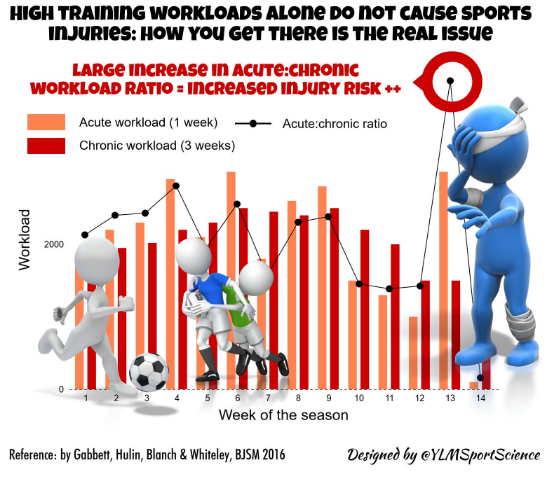
Does your body keep breaking down with ‘niggles’ when you start training or exercising?
A smarter approach to training will help reduce the risk of injury and allow you to train harder.
When someone with a sports injury presents to a Physiotherapy clinic, part of the Physiotherapist’s role is to assess the injury, the impairments that come with it and provide an appropriate management plan to get the patient achieving their goals again. The Physio will also attempt to figure out why the injury occurred and attempt to implement preventative strategies to make this the last time it happens.
In those with no obvious mechanism for a sports injury, a physiotherapist will assess an athlete not only in their acute presentation, but also ask questions regarding their previous workload/training load. Workload/training load can be measured in different ways – perhaps the most simplest is the external load or training volume (time spent training) multiplied by internal load or rate of perceived exertion (10 point scale describing an athletes perceived effort – low is easy, high is difficult). This gives a number labelled “arbitrary units” that measures internal and external training load.
Training session load = Minutes spent training x RPE (0-10)
An athlete’s acute load is measured by the present week’s total arbitrary units and is said to determine their ‘state of fatigue’. Chronic load is the average weekly load of the past 4 week’s arbitrary units and is a measure of their ‘state of fitness’.
Acute Load = Sum of week’s training session load
Chronic load = (sum of last 4 weeks acute load)/4
Studies in elite sport (Cricket, Rugby League and AFL) have shown that comparing an athlete’s acute load with their chronic load can be a powerful predictor of non-contact soft tissue injuries. When a player’s state of fatigue was 1.5 x (or more) their state of fitness, players were ‘70 times more likely to sustain an injury in the following week’. (Gabbett 2016)
This data set also confirms that heavy chronic training load can be preventative and reduce the risk of of soft tissue injuries. If progressive training loads are managed well, an athlete can train harder and longer without the increased risk of injury.
In some circles there is a misconception about Physiotherapists being too conservative – unnecessarily pulling players out of training and games due to risk of injury. With knowledge of appropriate load management, Physios/Exercise Physiologists know the value of hard training and are able to guide patients to achieve their fitness goals whatever they might be, whilst minimising risk but importantly, maximising your body’s resilience to soft tissue injuries.
If you would like further information on load management and maximising your training without increased risk of injury, please don’t hesitate to contact us at Capital Clinic Physiotherapy.
Gabbett, T. J. (2016). The training-injury prevention paradox: should athletes be training smarter and harder?. British journal of sports medicine, bjsports-2015.


